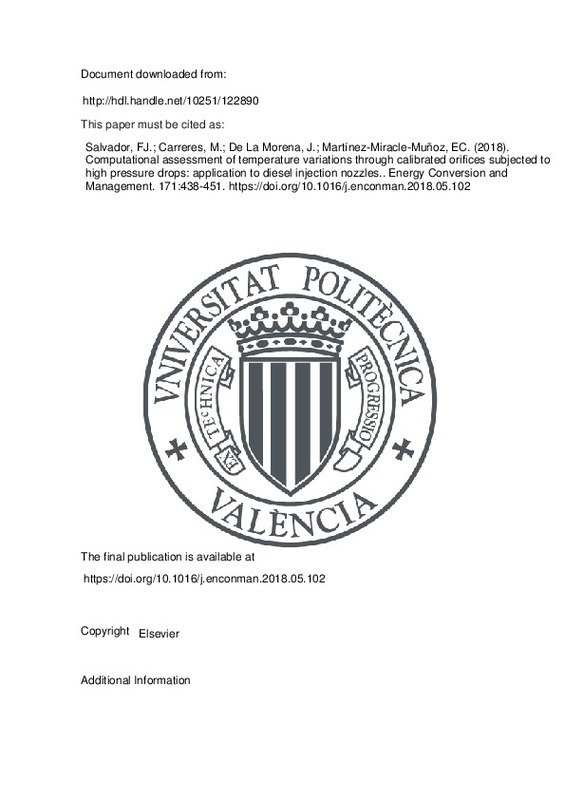JavaScript is disabled for your browser. Some features of this site may not work without it.
Buscar en RiuNet
Listar
Mi cuenta
Estadísticas
Ayuda RiuNet
Admin. UPV
Computational assessment of temperature variations through calibrated orifices subjected to high pressure drops: application to diesel injection nozzles
Mostrar el registro sencillo del ítem
Ficheros en el ítem
| dc.contributor.author | Salvador, Francisco Javier
|
es_ES |
| dc.contributor.author | Carreres, Marcos
|
es_ES |
| dc.contributor.author | De La Morena, Joaquín
|
es_ES |
| dc.contributor.author | Martínez-Miracle-Muñoz, Enrique Carlos
|
es_ES |
| dc.date.accessioned | 2019-06-28T20:05:04Z | |
| dc.date.available | 2019-06-28T20:05:04Z | |
| dc.date.issued | 2018 | es_ES |
| dc.identifier.issn | 0196-8904 | es_ES |
| dc.identifier.uri | http://hdl.handle.net/10251/122890 | |
| dc.description.abstract | [EN] This paper conducts an investigation on the temperature variations experienced by the fuel when it expands through the calibrated orifices of a commercial diesel injector. Experimental results of the temperature change across a calibrated orifice upon expansion, extracted from a previous work, are compared to the temperature predicted by computational fluid dynamic simulations under the assumption of adiabatic flow, with no heat transfer to the surroundings. The comparison points out that the simulations are able to predict the thermal effects taking place inside the orifice. Once the model is validated, the flow morphology is analyzed to explain the trends observed in the fuel temperature change across the orifice depending on the operating conditions. Two opposed effects take place inside the orifice: on the one hand, the flow is cooled in the orifice core due to depressurization; on the other hand, the fuel is importantly heated near the walls due to viscous friction. As expected, the net effect on the outlet temperature mainly depends on the orifice discharge coefficient, governed by the orifice geometry and the flow regime (Reynolds number) induced by the injection conditions. Next, the analysis is extended to a diesel nozzle, considering that the higher pressure drops achieved in it are expected to induce even more important thermal effects. The two opposed effects also take place inside the orifice. Even though their net effect is similar, the separate effect of each phenomenon is greater, leading to differences that could be relevant for the atomization and spray formation processes. Additionally, the flow pattern shows a non-uniform distribution of the flow inside the nozzle influencing the results from the thermal point of view. | es_ES |
| dc.language | Inglés | es_ES |
| dc.publisher | Elsevier | es_ES |
| dc.relation.ispartof | Energy Conversion and Management | es_ES |
| dc.rights | Reconocimiento - No comercial - Sin obra derivada (by-nc-nd) | es_ES |
| dc.subject | Thermal effects | es_ES |
| dc.subject | Injector | es_ES |
| dc.subject | Modelling | es_ES |
| dc.subject | Compressibility | es_ES |
| dc.subject | Fuel properties | es_ES |
| dc.subject.classification | MAQUINAS Y MOTORES TERMICOS | es_ES |
| dc.subject.classification | INGENIERIA AEROESPACIAL | es_ES |
| dc.title | Computational assessment of temperature variations through calibrated orifices subjected to high pressure drops: application to diesel injection nozzles | es_ES |
| dc.type | Artículo | es_ES |
| dc.identifier.doi | 10.1016/j.enconman.2018.05.102 | es_ES |
| dc.rights.accessRights | Abierto | es_ES |
| dc.contributor.affiliation | Universitat Politècnica de València. Departamento de Máquinas y Motores Térmicos - Departament de Màquines i Motors Tèrmics | es_ES |
| dc.description.bibliographicCitation | Salvador, FJ.; Carreres, M.; De La Morena, J.; Martínez-Miracle-Muñoz, EC. (2018). Computational assessment of temperature variations through calibrated orifices subjected to high pressure drops: application to diesel injection nozzles. Energy Conversion and Management. 171:438-451. https://doi.org/10.1016/j.enconman.2018.05.102 | es_ES |
| dc.description.accrualMethod | S | es_ES |
| dc.relation.publisherversion | https://doi.org/10.1016/j.enconman.2018.05.102 | es_ES |
| dc.description.upvformatpinicio | 438 | es_ES |
| dc.description.upvformatpfin | 451 | es_ES |
| dc.type.version | info:eu-repo/semantics/publishedVersion | es_ES |
| dc.description.volume | 171 | es_ES |
| dc.relation.pasarela | S\363351 | es_ES |







![[Cerrado]](/themes/UPV/images/candado.png)

